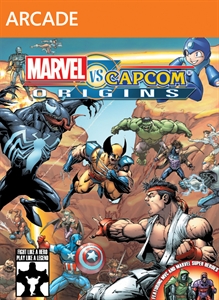
Marvel vs. Capcom Origins
Publisher: Capcom
Developer: Iron Galaxy
Platforms: XBLA (reviewed), PSN
Release Date: September 26, 2012
Price: 1200 MSP – Here
Overview
It is important to understand that Marvel vs. Capcom Origins is not a new game but a combination package of two revamped late 90’s Capcom titles – Marvel Super Heroes and Marvel vs. Capcom: Clash of Super Heroes. First released on the Capcom Power System 2 (CPS-2) was Marvel Super Heroes. Eventually the game was ported to the Sega Saturn and Playstation consoles in 1997. In 1998, Marvel vs. Capcom: Clash of Super Heroes was made public in arcades around the globe. Interesting but not absurd, both titles started out in arcades and then flourished to consoles. Now both titles have been revamped with some new kicks and thrown onto the online markets of both Xbox Live and Playstation Network. How will these later 90’s games hold up against their newly released counterparts?
Story
While fighting games hardly carry a story, each of these titles have a drivable purpose to complete the single player mode. Marvel Super Heroes has a storyline based on the collection of the Infinity Gems – gems that can be collected and used during play. As the player progresses, the goal is to collect all of the gems by defeating foes. By hoarding all the gems, your character has gained the attention of powers comparable to Dr. Doom. Thanos snatches all but one Infinity Gem and battles you using the powers of each gem. Defeating Thanos as good or evil will provide the player with an end story about that character.
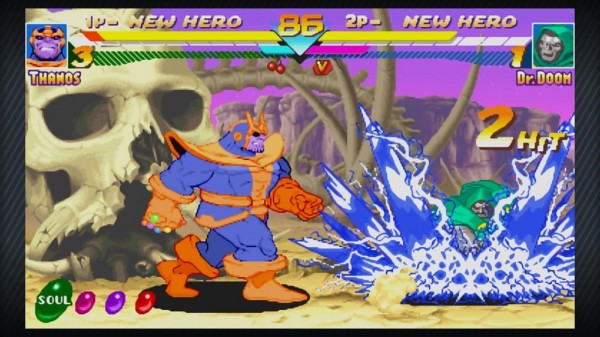
Marvel vs. Capcom: Clash of Super Heroes provides a less structural storyline as a multitude of characters are present from more than one title. However, the story bases itself around the Marvel universe where Professor Xavier is warning the heroes that his joining with Magneto’s mind must be stopped. The combination would create the deadly mutant named Onslaught who is a deadly force. Did the heroes stop battling each other to take heed on Xavier’s warning? You would like to think so.
Gameplay
Marvel Super Heroes
Each title’s gameplay will be discussed separately for original game taste then judged on the new additions made to the titles conjointly. To start off Marvel Super Heroes provides a small character selection. Beginning with 10 characters, this can be seen as a lacking component in today’s market. In the 90’s, I am sure this title had earned its place among fighting games, but today’s market is about customization and variety. One great selling point about the Marvel character selection, however, is the option of choosing between hero and villain characters.
Marvel Super Heroes creates its own learning curve. While a discrete move list is provided, the discovery of secret moves – ones that will surely help you win a battle – may only appear after a given battle as a hint. Thus, training becomes important with a character in order to move forward in your single player mode. This leads us to the other side of the learning curve which is game difficulty. Players may choose between three settings when deciding to play: Normal, Turbo, and Auto. Normal setting keeps the fight at a slower pace and perhaps more understandable to a beginning player. Turbo picks up the pace and potentially yields a quicker win for advanced players or lucky button mashers. When playing on Auto, players are queued with on-screen tips and limited to only three fights for single player.
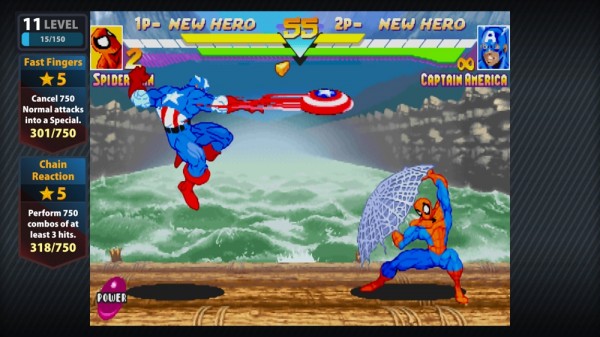
Next is the implementation of Infinity Gems. These devious little gems can provide great feats for your character if you can unleash their power. Understanding how to perform the correct combination of buttons is the key importance. If you cannot perform the move, the gems become useless unless they are on your person at the end of a winning round – loads of bonus points. Each gem carries its own ability like the Power gem enhancing a characters physical strength. Additionally, gems can have special effects for certain characters (i.e. Blackheart turns invisible when a Reality gem is used).
Marvel vs. Capcom: Clash of Super Heroes
As the latter created title, Marvel vs. Capcom: Clash of Super Heroes received diversity yielding a variety of characters from the Marvel and Capcom universe. While some characters like Magneto and Blackheart got the boot from Marvel’s corner, Capcom characters such as Megaman and Morrigan enter the fray. Additional to the selection of characters, players can alter the costume color providing an extra customization factor. During the selection screen of characters, players must pick not one but two characters for battle and attain a bonus character for special attacks. The special character can only be summoned a limited amount of times on the battlefield, so use their ability wisely.
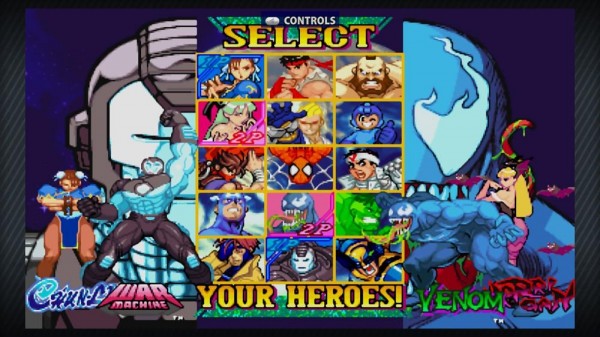
Still on the selection screen, the first mode selection prompted is the choice between Manual and Easy. Manual provides a challenge for those that wish to master the every move in a character’s arsenal including special power attacks. Whereas in Easy mode, players can simply press the left trigger or left bumper to easily dish out a power attack when available. The second mode selection offers the player to choose between Normal and Turbo. Like before in Marvel Super Heroes, this selection determines the pace of battle. As a beginner, I started on Easy and Normal modes giving me the best chance of survival. Hardened challengers can take Manual and Turbo to prove test their mettle.
Similar to Marvel Super Heroes, the move lists are not fully identified for the player. Hints between completion/death screens will help you figure some important moves out as well as button mashing in the training arena. Sadly, this is where the game leaves you hanging, and you are forced to “cheat” – use the internet – to find the remaining combinations.
New Additions
Everything thus far has been a rundown on regular gameplay and not the new additions added to the title. Marvel vs. Capcom Origins offers a trophy collection which can be unlocked through gaining points while playing the game. For instance, a hidden character like “Thanos” can be added to Marvel Super Heroes by purchasing him for 150 vault points. Loads of artwork and cinematic videos can be unlocked through this process as well. In junction with the overall completion status set at the main menu screen, these additions offer a player re-playability to the combined titles. Achievements and challenges also offer more aspects for a player to achieve generating an even lengthier experience for those completion hungry gamers.
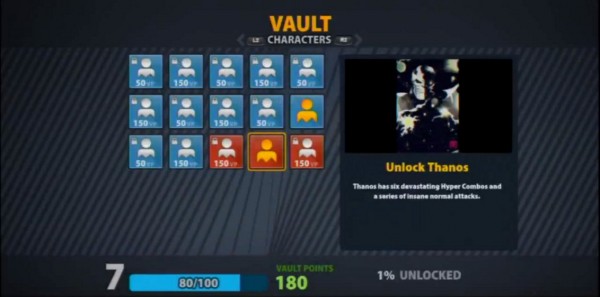
Unlike the 90’s versions of these titles, players can now battle online in ranked matches and even watch in a spectator mode. Ranked matches work well as an opponent is chosen closest to your rank score – begins at 2500. Upon winning a ranked match, a players rank will rise and vice versa for losing a battle. Another addition made just for online games is the inclusion of the “save replay”. After each online battle the player may choose to save the replay of the previous match. Perhaps a friend didn’t believe you unleashed an infinite combo against another player. Now you have the proof.
Visual / Audio
When boasting HD graphics, you have to look at the previous quality of the work and compare it with what is new. For me, the only drastic difference that I saw in the game was the user interface. The opening menus were welcoming and provided good transitions between titles. A new user interface was noticed while engaged in battles as the surrounding screen provided progress in player’s challenges. If the special effects for the character abilities were enhanced, the changes were not as drastic. This can be viewed as a positive aspect as well because of retaining the nostalgic view.
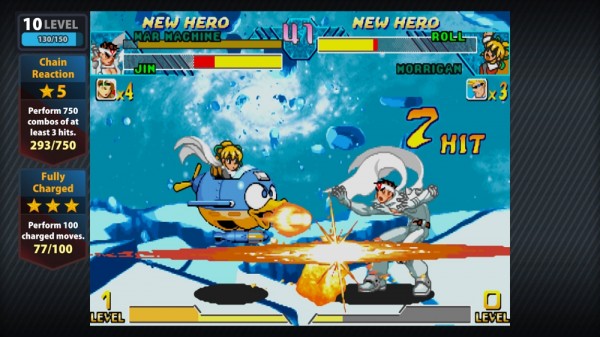
The audio is what you can expect from 90’s fighting games. Kicks, punches, grunts, and death wails offer auditory sustenance for the game’s sound effects. However, the entrance music for each title can seem quite repetitive. While these themes offer the nostalgia of the individual titles, perhaps new tracks could have been developed and intermixed to reduce the repetitive nature.
Overall
Classic fighting titles are difficult to review as they hold memories to those that grew up with them within a generation. As games progressively become finer tuned with HD graphics, achievements, and online play, original titles can be brought back to life. However, the problem faced with revamping older titles is not only original look, but how it faces with the most recent releases in its genre. Marvel vs. Capcom Origins may prove to be a decent set of two games combined under one package, but the release of Marvel vs. Capcom 3 and future titles will likely draw attention away from it.
Online play and save replays have never been included in these games before. This can be exciting for those that wish to partake in these older titles online. But I feel that newer titles have more aspects to offer like better graphics, larger variety of characters, and even 3D environments. Marvel vs. Capcom Origins proves that old games can add in new tricks, but the younger titles just have them outclassed in more than one area. Must be the steroids.


